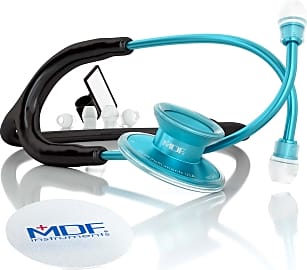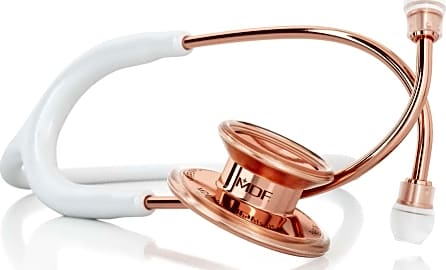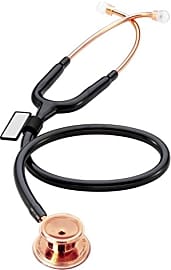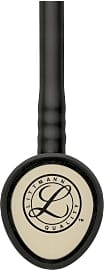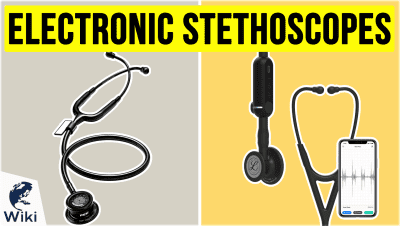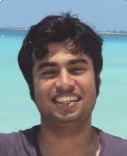The 10 Best Stethoscopes

This wiki has been updated 39 times since it was first published in September of 2015. A durable and reliable stethoscope is a must for many healthcare professionals, such as doctors, nurses, paramedics, physician's assistants, and veterinary technicians. Our selection features classic models with a basic bell-and-diaphragm design, as well as convenient, tunable choices that can capture low- and high-frequency sounds with a simple change in applied pressure. When users buy our independently chosen editorial selections, we may earn commissions to help fund the Wiki.
Editor's Notes
April 21, 2021:
I didn’t think much was in need of change during this update. The only model I’ve taken out is the MDF ER Premier, due to availability issues, which I’ve replaced with another model from the same brand – the MDF Rose Gold. This list is otherwise populated by lots of models from 3M Littmann and, to a lesser extent, MDF. That’s okay, and I was tempted to add an option from Paramed too, but was ultimately not too impressed by their surprisingly narrow range of stethoscopes, despite the fact that they otherwise make excellent paramedic equipment.
January 04, 2020:
This update sees the addition of another model from MDF Instruments, the MDF Acoustica Deluxe, which is easy to switch between the bell and diaphragm sides when you rotate the acoustic valve. Each side clicks into place, accordingly, and a green indicator light helps you to know which of the two channels is currently activated. A patented metal-alloy chamber inside the acoustic tubing keeps it open for maximum sound transmission into the headset, helping you to hear even fainter sounds clearly. This model is handcrafted from premium aluminum, with a chestpiece that’s precisely machined and hand-polished for durability.
Also new to the list is the Björn Hall STHLM-610, which was designed by nurses, for nurses. It’s lightweight, ergonomically designed – and fashionable, to boot. It naturally complements the anatomy of the ear canal and is long enough so you won’t need to strain your back during patient assessments. It comes with a stylish carrying case, along with three sizes of ear tips, small and large diaphragms, and a comfortable, non-chill rim.
It’s hard to go wrong with a 3M Littman, and our list features acoustic models like the 3M Littmann Cardiology IV, the 3M Littmann Classic III, and the 3M Littmann Lightweight II, all of which feature tunable diaphragm technology and ergonomic, lightweight builds. The 3M Littmann Master Cardiology delivers the manufacturer’s highest acoustic performance, with a diaphragm that responds with a simple pressure change to capture low- and high-frequency sounds. It’s a great investment made to last for years of use, making it well suited for cardiologists, anesthesiologists, ER doctors, respiratory specialists, and more. It also makes for a nice gift for any medical school student or recent graduate.
For a model that can electronically amplify body sounds by converting acoustic sound waves into electrical signals, see our list of best electronic stethoscopes.
Special Honors
Hopkins Medical Products Pediatric Stethoscope Your young patients will remain comfortable during their assessment with this stainless steel model, thanks to its non-chill bell and diaphragm retaining ring. Its large bell (1-1/8 inches in diameter) provides an impressive low-frequency response, while its ultra-sensitive diaphragm (1-3/8 inches in diameter) fosters greater amplification and crisper high-frequency transmission. It’s also comfortable for the wearer, since it weighs only 5.3 ounces and comes with both small and large PVC ear tips. A spare diaphragm is also included. You can buy it with confidence, thanks to its lifetime warranty. hopkinsmedicalproducts.com
Hopkins Medical Products Infant Stethoscope Designed for the tiniest of patients, this model features a small bell diameter (only 7/8 inches) and diaphragm (1-1/8 inches). It has a reinforcing yoke for durability that’s molded into flexible, 22-inch PVC “Y” tubing. It’s available in your choice of pink, gray, or blue. It comes from a manufacturer that has been designing unique and hard-to-find healthcare products since 1945. hopkinsmedicalproducts.com
An Acoustic Tool Of The Trade
The tubing is usually made of a combination of sturdy rubber and metal.
If it's just about time for your annual physical or you require a trip to the doctor's office, it's likely that your doctor will use a series of tools to determine your current state of general health. You'll more than likely see your physician use an otoscope to look inside your ear canals, a scale to check your weight, a reflex hammer to check for neurological abnormalities, and a stethoscope to listen to your heartbeat and breathing.
It is the stethoscope that is most closely associated with a trip to the doctor's office, particularly for kids who need regular checkups. Regardless of the situation, the stethoscope is a necessary part of the medical tool arsenal that a doctor has at his or her disposal.
The stethoscope is an acoustic medical device for listening to the internal sounds of a person or animal's body parts. This listening action is often referred to as auscultation. A doctor or nurse will often use a stethoscope to listen for abnormal rhythms of a person's heartbeat, breathing irregularities, compromised lung functions, intestinal noises, and to monitor blood pressure.
Stethoscopes are composed of three major parts that include the chest piece, tubing, and the headset. The chest piece consists of both a diaphragm and bell. The diaphragm is made up of a plastic piece residing inside a silver metal piece. It is this silver metal piece that actually touches a patient. The bell detects sounds at low pitches, while the diaphragm detects those at high pitches. The tubing is usually made of a combination of sturdy rubber and metal. It connects the chest piece to the headset.
The tubing is primarily responsible for carrying the sounds, detected by both the bell and diaphragm, directly to the headset. The rubber portion of the tubing connects to metal tubing closest to the headset, which ultimately directs sound to the doctor's ears. Eartips at the end of the metal tubing are usually insulated with rubber to minimize the impact of surrounding noise on a doctor's interpretation of the sounds he or she is listening to when examining a patient. Just as the eardrum vibrates when sound waves pass through it, so does the diaphragm on a stethoscope's chest piece. The vibrations move through the rubber tubing, through the metal tubes, and into a doctor's ears.
The two major types of stethoscopes include acoustic and electronic. Acoustic stethoscopes are the most familiar and operate via sound transmission from their chest pieces. Electronic stethoscopes are capable of amplifying a detected body sound; they operate wirelessly, and can even record sound waves for review on a computer if necessary.
This device makes individual body sounds easy to distinguish and it's not painful to the patient. Although the stethoscope is usually associated with the medical profession, it can also serve other purposes. For example, a mechanic can use the device to diagnose engine problems with an automobile by listening to the sounds of its moving parts. It can also be used to detect leaks inside of a vacuum chamber.
A Brief History Of The Stethoscope
The stethoscope was invented in France in 1816 by physician René Laennec at the Necker-Enfants Malades Hospital in Paris. Its original design was monaural (a single channel of sound coming from one position) and consisted of a long wooden tube.
Cammann's design became the standard for the medical stethoscope that is still in use today.
Due to both the age and gender differences among his patients and the hands-on nature of his job, Laennec felt uncomfortable placing his ear directly against the chests of his patients. The wooden tube allowed Laennec to listen to a patient's heartbeat without making physical contact with his own body.
In 1852, George Philip Cammann perfected his design of the binaural stethoscope for commercial production. This stethoscope was more durable than Laennec's design with individual earpieces so that the sound could reach both ears simultaneously. Cammann's design became the standard for the medical stethoscope that is still in use today.
Fast forward to the 1940s when Rappaport and Sprague redefined the standard for most other stethoscopes made during that time. Rappaport and Sprague devices were made with two sides, one used for listening to the respiratory system, while the other was used for the cardiovascular system. This design persisted for decades until it was finally abandoned around 2004.
By 2015, an open-source project for the 3D-printed stethoscope made the device much more affordable and accessible than ever before, particularly for developing countries.
Choosing A Stethoscope
When choosing a stethoscope, the particular profession you have in mind is an important consideration. A cardiologist, for example, would benefit from a stethoscope that can easily detect both high and low-pitched sounds, regardless of how faint they might be.
One must also be sure that the earpieces fit snugly and comfortably in the ears for the best accuracy when making a diagnosis. The tubing for your intended device should also be durable and well insulated in order to prevent external noise interference.
The best stethoscopes feature high-density chest pieces made from either steel or titanium for the best sound conduction. The chest piece should also be hand-polished on both its inside and outside for producing the most crisp sound possible.
The device is also available in an array of different colors, which is particularly useful for pediatricians who may be working with a lot of young kids.


